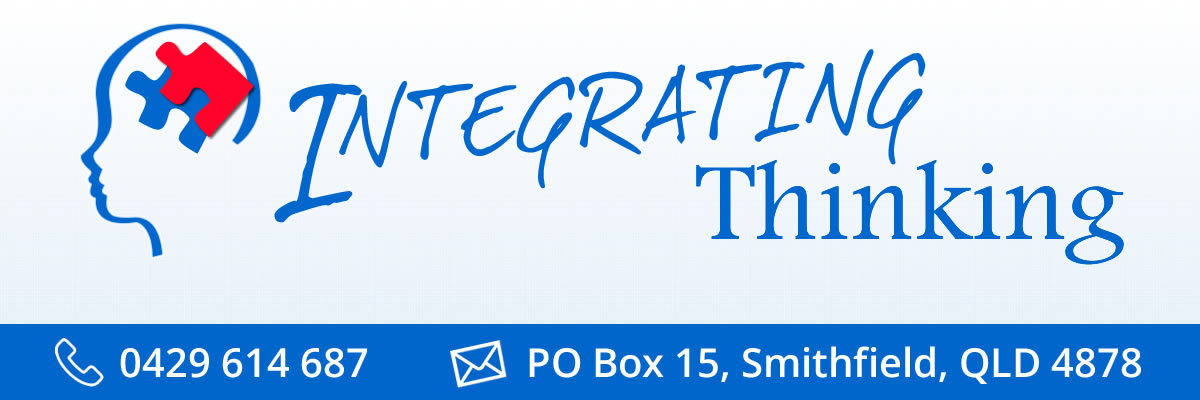

As of January 2022, we’ve started to house our Blog posts on our “Body to Brain Learning” Website: bodytobrainlearning.com/blog
The first blog for 2022 is all about “Learning Readiness and School Readiness”. They’re different!
I hope you enjoy it. Please share your thoughts and, if you want to be informed when new posts are made, I suggest you sign up for our mailing list so we can keep you in the loop about the news and updates we post. Click here to complete that form.
 “Which course?” … There are two Educator based PD courses in the Body to Brain Learning (R) suite of courses. Both are great for teachers and address AITSL standards. I’ve been asked recently: Which is best for me? What’s the difference? And, which one should I do for some body-based learning CPD so I can use this approach in our school?
“Which course?” … There are two Educator based PD courses in the Body to Brain Learning (R) suite of courses. Both are great for teachers and address AITSL standards. I’ve been asked recently: Which is best for me? What’s the difference? And, which one should I do for some body-based learning CPD so I can use this approach in our school?
These Body to Brain Learning (R) Courses are designed mainly for Educators: “My Body Learns First @ School” and “How the Body Tells the Learning Story” (R) So what’s the difference? Several attendees at our free Masterclass: “The Role of the Body in Learning” that I held on March 30th, 2021 asked me that exact question (and more). Here are some answers:
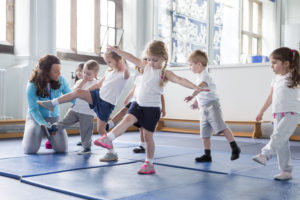
My Body Learns First @ School
 “How the Body Tells the Learning Story (R)” is an introductory course for those who want to know more about what to look for when a child may present with learning difficulties or challenges, or is not performing to their potential and how the body indicates what may be underlying those learning difficulties. This course helps teachers identify the cues that suggest there may be neuromotor and sensory developmental immaturity and provides some basic neurodevelopmental information that explains this foundational aspect of learning.
“How the Body Tells the Learning Story (R)” is an introductory course for those who want to know more about what to look for when a child may present with learning difficulties or challenges, or is not performing to their potential and how the body indicates what may be underlying those learning difficulties. This course helps teachers identify the cues that suggest there may be neuromotor and sensory developmental immaturity and provides some basic neurodevelopmental information that explains this foundational aspect of learning.  The INPP Practitioner Course may interest you if you want to delve further into the concept of neuromotor immaturity. It is a four Module postgraduate level course that provides more detailed understanding of ways to assess and address neuromotor immaturity from a clinical and therapeutic perspective using the INPP (R) method. Teachers, allied health care practitioners including optometrists, occupational, speech and physiotherapists, osteopaths, and others working with children with learning challenges and dysfunctions have completed this course. This course provides greater insight and understanding into neuromotor immaturity and the clinical application of the INPP (R) Method. It enables practitioners to help individual children/students/adults on a one to one clinical basis. Dr Christine Payard (PhD) is the INPP Australia Principal providing training in the INPP method in Australia and New Zealand.
The INPP Practitioner Course may interest you if you want to delve further into the concept of neuromotor immaturity. It is a four Module postgraduate level course that provides more detailed understanding of ways to assess and address neuromotor immaturity from a clinical and therapeutic perspective using the INPP (R) method. Teachers, allied health care practitioners including optometrists, occupational, speech and physiotherapists, osteopaths, and others working with children with learning challenges and dysfunctions have completed this course. This course provides greater insight and understanding into neuromotor immaturity and the clinical application of the INPP (R) Method. It enables practitioners to help individual children/students/adults on a one to one clinical basis. Dr Christine Payard (PhD) is the INPP Australia Principal providing training in the INPP method in Australia and New Zealand.If you would like to learn more about our work; about training programmes and our offerings of training events, then please sign up for more information so that we can email you the details as they come to hand.
Email us: admin@integratingthinking.com.au
I look forward to the possibility of working with you on one of our courses. The people who do this work make a difference in the lives of children, adults and their families. I love helping those people make that difference by sharing my knowledge and experience.

Christine Payard (PhD) is the Director of Integrating Thinking ® and the founder of the Body to Brain Learning ® Series. A neurodevelopmental educator, author, presenter, and researcher, Christine has studied extensively in the area of literacy, learning, teaching, neuromotor and sensory development and ways the body supports the learning process. She can be contacted by email: admin@integratingthinking.com.au
#body_to_brain_learning #integratingthinking #reading #learning #neuromotorimmaturity #bodystories #primitivereflexes #vision #visualprocessing #vision #inpp #inppaustralia
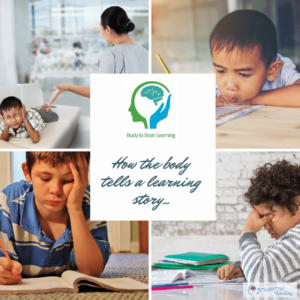 The Body Tells a Learning Story: An Introduction.
The Body Tells a Learning Story: An Introduction.When we think of academic learning we usually think about the brain and how it works, and how we can manage our brain functions to learn better. But, it’s often the body that tells us about how the brain is operating and supporting learning for our students.
We need to learn to read that body language. It tells us HOW our students learn.
Here’s some more information about WHY this perspective is so important for educators:
Learn more about the upcoming training programme I mention in this video (including a free Masterclass) click on this button:
"How the Body Tells the Learning Story." Course info. 2021
To stay informed about other things connected to the “Body to Brain Learning” theme, sign up for our email updates. Click on this button:
 About me: I’m Christine Payard (PhD). I’m an educator, with a passion for learning: how we learn and how to help others learn. I look at learning from a neurodevelopmental perspective because I’ve learned that if the body doesn’t support learning, it can interfere with learning. That process starts early in our development and it’s how the body helps train the brain and supports ongoing function, including academic learning.
About me: I’m Christine Payard (PhD). I’m an educator, with a passion for learning: how we learn and how to help others learn. I look at learning from a neurodevelopmental perspective because I’ve learned that if the body doesn’t support learning, it can interfere with learning. That process starts early in our development and it’s how the body helps train the brain and supports ongoing function, including academic learning.
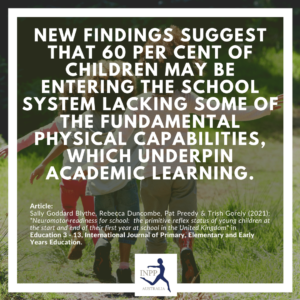 New Research:
New Research:This morning I received an email from Sally Goddard Blythe (Director of INPP International) regarding a new article she has co-authored with a research team in the UK.
| Screening Test Training Opportunities |
It will take you to an information page about the “Screening” courses we offer.

Christine Payard (PhD) is the Director of Integrating Thinking ® and the founder of the Body to Brain Learning ® Professional Development Series. An educator, researcher, author and presenter, Christine has studied extensively in the area of literacy, learning, teaching and ways the body supports the learning process. She is an Educator with a neuro-developmental focus. She can be contacted by email: admin@integratingthinking.com.au
#body_to_brain_learning #integratingthinking #reading #learning #neuromotorimmaturity #bodystories #primitivereflexes #vision #visualprocessing #vision #inpp #inppaustralia #teaching #questions #checklist #learningsupport #helpingthebodysupportlearning
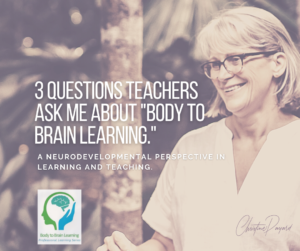 There are at least 3 questions teachers ask me about my work as a neurodevelopmental educator and consultant helping children with learning difficulties. I call it “body to brain learning”.
There are at least 3 questions teachers ask me about my work as a neurodevelopmental educator and consultant helping children with learning difficulties. I call it “body to brain learning”.
Here are the questions and some short (and longer) answers:
Body to Brain Learning® is a neurodevelopmental approach to education and understanding HOW we learn. Basically, It’s a developmental and functional view of learning. Our body needs to be developmentally mature and function well at the appropriate life stage for us to learn well.
Body to Brain Learning® is also a professional learning series to help me share this crucial information with educators and others who work with children with learning challenges. This knowledge was missing from my professional knowledge bank as a teacher. I know it’s missing from the professional knowledge banks of many others who work with children that experience learning and functional challenges, not just teachers.
In our Body to Brain Learning® PD Series, we teach you about what to look for and how to use this perspective (supported by brain science) in your learning based practice.
There are two parts to the longer answer:
Body to Brain Learning® is all about the learning process. HOW we learn.
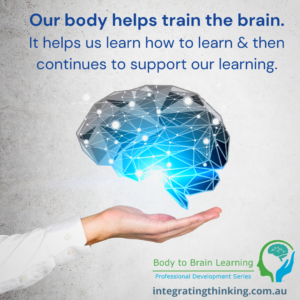 It’s about how we learn as humans from a developmental, body perspective. It acknowledges that we learn with and through our body.
It’s about how we learn as humans from a developmental, body perspective. It acknowledges that we learn with and through our body.
It is about identifying how our body impacts our learning.
It examines how body systems directly impact our learning success from a neurodevelopmental perspective and is a way of working in education, and, in learning support agencies/professions.
Our brain processes information it receives through the body and that enables us to learn and use that information in different academic, life and social contexts. That’s one way that our body helps our brain to learn.
If the body isn’t supporting our brain to receive and effectively process information from the world around us, then things can go awry in the learning process and learning can be a struggle.
We see evidence of immature body systems in the way children approach learning tasks such as reading, writing, mathematics, physical education and more. We can see in their posture, movement and behavioural responses that their body is not making academic learning easy; in fact, it may be complicating it. We are talking about immature neuromotor and sensory systems.
This neurodevelopmental lens as a teacher helps us modify our pedagogic practice to enhance student learning and potential. By understanding neurodevelopmental aspects of the learning process and what to look for in students neurophysiological behaviours, we gain a better understanding of HOW our students learn. (That’s AITSL standard #1)
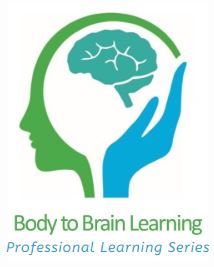 Body to Brain Learning® is also the name of a professional learning series for educators, health care professionals and families, who want to know more about how the body impacts learning potential and how the body helps support learning.
Body to Brain Learning® is also the name of a professional learning series for educators, health care professionals and families, who want to know more about how the body impacts learning potential and how the body helps support learning.
Body to Brain Learning® was founded by Dr Christine Payard (PhD) with the intention of making this neurodevelopmental approach to learning and teaching easy to understand and implement in practice.
It helps professionals (not just teachers) learn and apply concepts of neurodevelopment in their practice to help children and adults who may have learning challenges that are neurodevelopmentally based.
The first series for educators (“How the Body Tells the Learning Story”) provides introductory information and insight into how the body tells us about the learning stories of our students. It helps educators observe and begin to interpret the learning story the body is telling us about each of our students in our classrooms. Other Professional Development programmes can be found on the training page of our website: integratingthinking.com.au/training
No, that’s not all you need to know and, no, it is not enough.
While running around and general movement is incredibly important, so is an educator’s understanding of the developmental sequence of our neuro-motor and sensory systems and how they underpin successful academic learning. That’s the Body to Brain Learning® function that interests us. Here’s why:
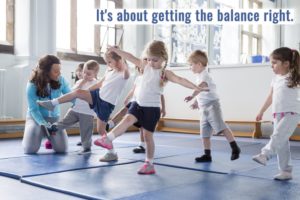
Developmental movement sequences matter.
Body to Brain Learning® is a way of thinking about learning and how we learn. It’s about how the body helps the brain to learn using a neurodevelopmental perspective.
A neurodevelopmental lens in our teaching practice improves our teaching because of the insight it provides into HOW students learn.
Body to Brain Learning® is a neurodevelopmental approach that acknowledges we aren’t born to run, walk and talk immediately, and, our brain isn’t ready to learn academically until some of the body stuff is well developed.
Our body and brain need to progress through milestones and neurodevelopmental pathways to develop our senses fully and integrate them appropriately with our neuromotor systems. Each stage and sub-stage of development needs to fulfil a neural wiring, processing and functioning purpose.
Our body systems need to work together to support the “top-level” brain learning activities that our schooling systems and academic learning require.
Body to Brain Learning ® considers the developmental sequence of the early years and its impact on later learning at any age. It’s not just about when a child starts school. This isn’t just early childhood information. Here’s why:
We know the first three years of life are crucial for laying the foundations for learning success. Sometimes, due to any number of reasons, the body’s neuromotor and sensory systems don’t mature enough in that time to support the academic learning requirements our children face when they go to school. This immaturity can limit a child’s ability to learn and function in different contexts across their lifetime. Practitioners like me work with children, adolescents, young adults and older adults with this body system immaturity.
Body to Brain Learning ® uses concepts and theories of neurobiology, neuroplasticity, neuropsychology, child development, and education to look at how the body supports learning. It helps teachers (and other professionals working with children who have learning challenges) look at learning from a developmental and functional perspective. It asks: “How does the child’s body support their learning? Can we help improve their learning experience, particularly children with learning challenges? How can we mature these systems so that we can make the learning journey easier and more successful for our students who need help in this area? How can we help their function?”
Our focus in Body to Brain Learning ® is on developmental movement and the role it plays in supporting the learning process. This movement is different from the movement that supports health and fitness.
Well developed, mature neuromotor and sensory systems provide the foundations of success for a child’s learning journey. They mature through developmental movement sequences. We explore this concept of movement, its neuromotor and sensory connections, and assess and understand its impact on learning.
If a child has immature neuromotor and sensory systems, they are likely to struggle to control aspects of their body. This can impact their learning experience and success (eg. the child who can’t sit still, who is constantly distracted or distracts others, who can’t read and write well despite being motivated to learn, and so on).
Knowing what to look for in the body language of the students we teach (including how they move, sit and behave in class) gives us insight into how the student’s body supports their learning. A Body to Brain Learning ® approach is built on the premise that the body tells us a story about how students learn.
If the body doesn’t support learning, it can interfere with learning.
As teachers, we need to be able to identify if a student’s body and body processes are supporting their learning journey, or, interfering with it. This view of movement is different from getting the children to move more for health and wellbeing.
By identifying and interpreting the body story, we gain a better understanding of HOW our students are learning. And, if necessary, we can revisit developmental movement patterns to help mature our neuro-motor and sensory systems so that our students’ bodies function more effectively to support their learning.
It’s about knowing how movement contributes to a student’s learning journey and supports their academic learning function. That’s the “movement” we are talking about.
I can send you the “Body to Brain Learning® Checklist for Educators”. Once you download it, you can observe if the student(s) you have in mind tick the boxes that may indicate there could be a body-based, neuro-developmental issue that is impacting their learning.
Here’s the link to sign up and receive that resource (and more information about what to do with it):
Send me the "Body to Brain Learning Educator's Checklist."
When I ask the children with whom I work what they think/feel is happening with their body at school, I often get answers like they are “I’m fighting my body.” (Yes, some use those exact words).
So, what does this struggle look like?
Well, it can be different for each child, but, there are often similarities in behaviours, postures and approaches to classroom-based activities.
Once you see the body cues and understand what those body cues are telling you about how their bodies are impacting their learning, you can’t “unsee” them.
The easiest way I suggest to start identifying these body cues is to use the “Body to Brain Learning® Checklist for Educators”. Here’s a snippet from the checklist:
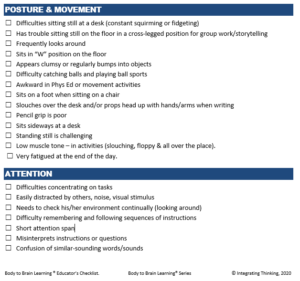
The “Body to Brain Learning® Checklist for Educators” includes other observations such as reading & writing behaviours, listening, vision, spatial awareness, social interaction, speech, vocabulary, a student’s demeanour and their attitude in class.
The checklist is a resource to help you start to look at your students with a “body to brain learning” perspective/lens so you can start to see how students are learning with their body.
Included in the checklist is an introductory explanation of what to do with the data you are gathering by using this observational tool. We give you guidelines to help you use this different lens in understanding HOW your students learn.
Remember, underpinning this work is the concept that if the body doesn’t support learning it can interfere with it, BUT, it can also tell us what is going on in a child’s learning journey. It can tell us that child’s learning story. The story of how they are using their body to support their academic learning.
So, what are the body stories that tell me about how my students learn? How do I read those stories?
Well, that’s another huge question…I’ll follow up with that in another conversation.
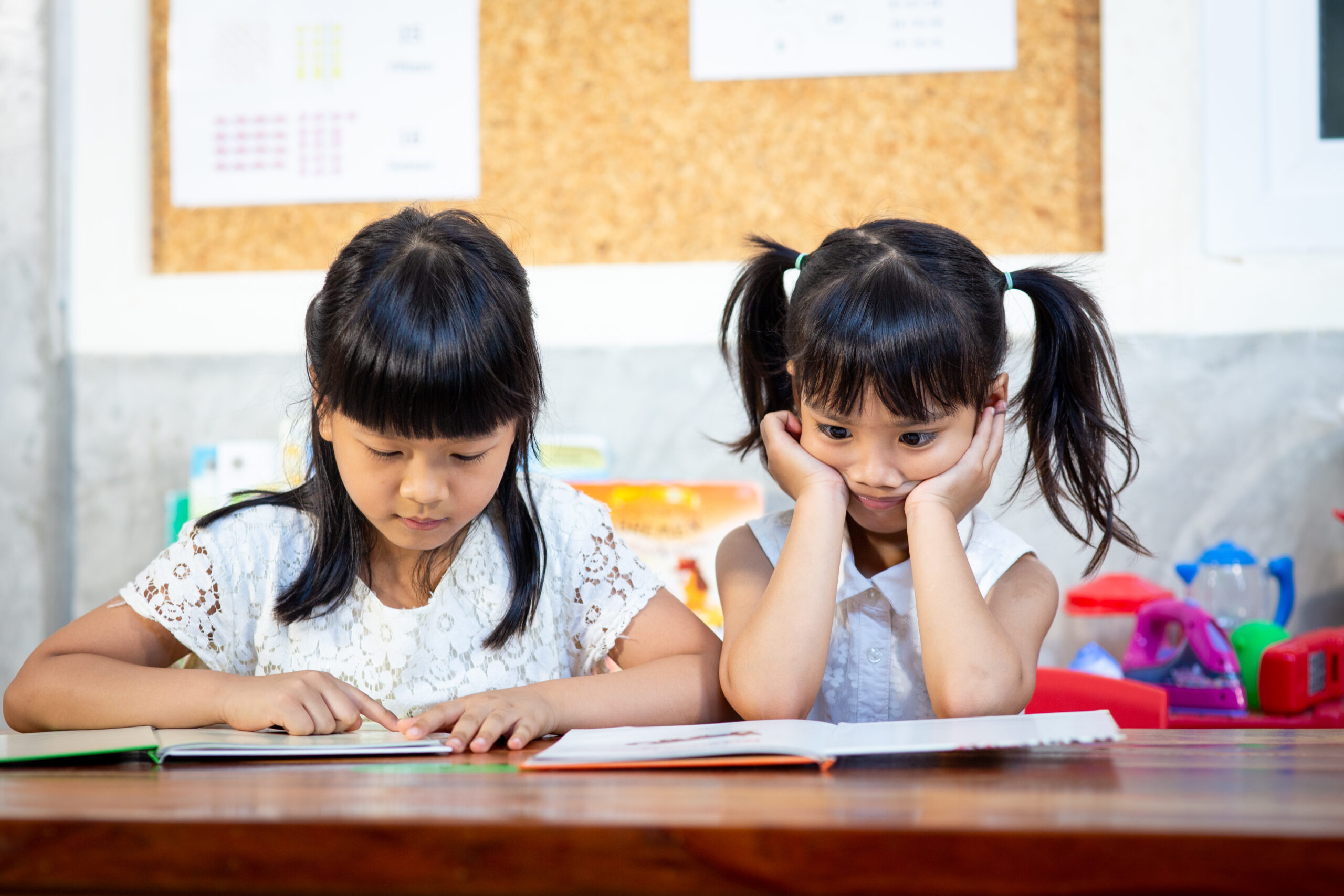
If you want to access the checklist and more information, here’s that link again:
Send me the "Body to Brain Learning Educator's Checklist."
When you sign up for our updates, I’ll keep you informed about blog posts, courses, articles and other things that focus on this area of learning, teaching and functional support.

Christine Payard (PhD) is the Director of Integrating Thinking ® and the founder of the Body to Brain Learning ® Professional Development Series. An educator, researcher, author and presenter, Christine has studied extensively in the area of literacy, learning, teaching and ways the body supports the learning process. She is an Educator with a neuro-developmental focus. She can be contacted by email: admin@integratingthinking.com.au
#body_to_brain_learning #integratingthinking #reading #learning #neuromotorimmaturity #bodystories #primitivereflexes #vision #visualprocessing #vision #inpp #inppaustralia #teaching #questions #checklist #learningsupport #helpingthebodysupportlearning
I was the child who could read a word on one page but could NOT read it on the next page. I know it frustrated my mother incredibly. ? (In fact, my father often jokes that I was lucky to survive the treacherous task of learning to read because it was so frustrating, infuriating in fact, for those who were helping me learn!)
Do you know a child like that? Yes? Well then, please be patient. Here’s why:
Reading is a highly complex task; cognitively AND physiologically.

Successful reading requires mature body systems that support reading. It requires more than just concentration and paying attention to the story we are reading, in fact, those processes come later when we can actually read. Let me explain a little bit about what I mean.
To read well we need well-developed ocular-motor skills, accurate and consistent visual perception, and the ability to match visual symbols and letter combinations with sounds. We also need to make meaning out of those squiggles and symbols and their combinations on the page (letters, words, sentences). That involves other processes and brain functions including some cognitive (thinking) activities. Once we have mastered those activities, then we can start to become fluent in identifying and interpreting script on a page to make meaning in our head (comprehension) and learn from the text on the page.
Sometimes reading can be confusing because the same letters and letter combinations sound different when they are in another word eg. “ou” sometimes sounds like “ooo” (in ‘you’) and sometimes it sounds like “ow” (in ‘sound’). We need to learn to identify those differences and when and where they happen in language. [Phonetics of English isn’t the easiest to learn because of these sorts of quirks and characteristics of how we represent sounds in written form. (Phonetics is basically the study of speech sounds, their production and combinations, and how we represent those with written symbols.) And, that’s why “sounding out words” can sometimes be frustrating and tricky for a new reader.]
If our eyes aren’t consistently working well together a “b” on one page may look like a “d” on another. That changes things for a new reader!
Sometimes our eyes aren’t actually pointing at the same word or letter and that sends different messages to the brain which is also confusing. Sometimes it seems like the words may be moving or “swimming” on the page. There are many visual distortions that can happen. A child isn’t usually aware that others who can read don’t see the page the way they do! Sometimes different fonts can confuse children’s ability to identify letters and their corresponding sounds. Have you ever had trouble reading cursive (running writing), but no problems reading print? Letters can look different in different fonts, yet they are the same letter. How does a child learn that “t” and “t” are the same, or that “g” and “g” are the same? They don’t look the same!
When a child has difficulties reading (like I did), it is not a reflection of their intelligence. It is more likely a reflection of something going wrong in the reading process.
We aren’t born with a fully mature body system that is capable of undertaking the complex task of reading. We learn to read and train our body to discern and understand the characteristics of our language in written form. It’s complex.
Initially, our body needs to develop the foundational skills and processes to support us in our reading, writing and learning tasks. That takes time. It requires developmental movement sequences and opportunities that most of us experience in our first 3 – 5 years of life. It requires opportunity and it may require support if it isn’t mature by the time we are at school.
If a child/student struggles with reading, it’s worth asking a professional who understands the physiology of learning, developmental patterns, and the complexity of reading for some advice. The child/student may need some support because, if their body isn’t fully supporting the reading and learning process, it may actually be interfering with the reading and learning process. In that case, the body can be helped to support the learning and reading processes.
Success in our school system requires success in reading and writing. We need to understand how the body helps support those tasks, because learning doesn’t just happen in the brain. It happens in and through our body.
If you want to learn more about this perspective on learning and how the body helps support and tell the story of our learning bodies, you can sign up for updates and information through our email list: integratingthinking.com.au/learnmore.

Christine Payard (PhD) is the Director of Integrating Thinking ® and the founder of the Body to Brain Learning ® Series. An educator, researcher, author and presenter, Christine has studied extensively in the area of literacy, learning, teaching and ways the body supports the learning process. She is an Educator with a neuro-developmental focus. She can be contacted by email: admin@integratingthinking.com.au
#body_to_brain_learning #integratingthinking #reading #learning #neuromotorimmaturity #bodystories #primitivereflexes #vision #visualprocessing #vision #inpp #inppaustralia
It’s January. The new school year is about to fire up in Australia.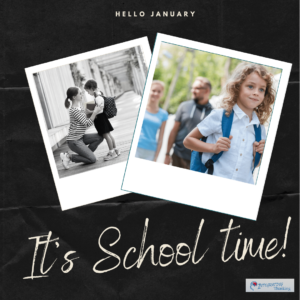
It is the time when we check whether children have the right books, bags, shoes, uniforms and stationery to begin their learning for the year so they can start with the best equipment to support their learning.
I argue it’s also a great time to consider whether they have the physical and neurological attributes and foundations necessary to help support their learning: to do a bit of a “check-in” on this crucial aspect of their “school readiness.”
That’s quite a mouthful though, so, what do I mean by that?
We know learning is more than just a “thinking” activity requiring concentration, focus and attention. It is also a body-based activity requiring a student to balance, coordinate their body and use their sensory systems well and together to support their learning journey. When “checking in” on these aspects of learning we are asking: “Are our student’s body systems ready for their upcoming learning journey?”
Just because a child has reached the magic chronological age for starting school, it doesn’t mean they are physiologically READY for learning in a school environment.
In some societies, it was customary for a parent/caregiver to bring a child in front of the community’s wise person and ask whether the child was ready for more formal learning. The story goes that one of the tests performed was to ask the child to stand on one leg. If that child could complete the task for a set time, he/she was considered ready.
Essentially, the child’s body and ability to balance in a static position determined their readiness and maturity for entry into a more formal school learning environment.
We don’t practice that concept in Australia. In fact, we rarely think about the role of the body in helping our students learn. Our focus is on the brain and how we use our thinking processes to succeed in school. In the early years, we focus on whether they know their letters, numbers and colours and how to start writing. We don’t check to see if a child’s body is ready for the academic learning experiences offered and the challenges the teacher will present in class and for completion at home.
We know that a developmentally immature child is more likely to struggle with learning tasks and activities than a neurologically and sensory mature student. It’s important to note I’m not just talking about pre-schoolers here. These students’ learning challenges can occur at any age and impact learning success and function at any year level. These students can find the whole school learning experience uncomfortable, challenging and unpleasant. If they don’t or can’t use their words to tell us about the challenges they are facing, their behaviour probably will, and the signs can show quite early in the academic year.
 A student’s body, posture and behaviour can tell us if they are ready for the new learning experiences of a school setting. We need to learn to look for those clues to determine readiness for academic learning and understand what those clues mean. Then, we need to help strengthen and mature these children’s foundations to better achieve their learning potential without first fighting their bodies to learn efficiently and effectively.
A student’s body, posture and behaviour can tell us if they are ready for the new learning experiences of a school setting. We need to learn to look for those clues to determine readiness for academic learning and understand what those clues mean. Then, we need to help strengthen and mature these children’s foundations to better achieve their learning potential without first fighting their bodies to learn efficiently and effectively.
In my neuro-developmental education practice, I see children who struggle with reading, writing, concentration, sitting still, auditory and visual processing difficulties, and other things associated with immature neuromotor and sensory systems. Often these students are not reaching what we know is their academic potential. They may dislike reading. They may find it hard to write clearly and neatly. They may not be able to sit still on the classroom mat and pay attention to what is happening in their instructional opportunities. They may forget instructions quickly and provoke or interrupt others in their learning. The key to these issues isn’t their lack of focus or discipline. It’s how their body supports their learning processes.
Children with neuromotor and sensory immaturity come with varied and mixed presentations. They are sometimes diagnosed or described with terms such as “dyslexia”, “dyspraxia”, “dysgraphia”, ADHD and others. Often there is an underlying common developmental immaturity issue that we can identify and address.
We can mature body systems using non-invasive developmental movement patterns. Academic performance and function are often enhanced as a result. Teachers frequently comment on how much easier the school experience is for that child who is no longer “fighting” their body to learn. Life is easier for everyone, especially the child who wasn’t really “school ready”.
As the school year begins, we don’t just need to make sure children have the right equipment and clothing to be ready for school. We need to check they are physiologically prepared. Because we learn through our body, our body has to be ready to support our learning.
School readiness is real and is body-based. It isn’t just about attitude and motivation.
If a child or student experiences challenges with learning, dislikes reading, can’t sit still, struggles with maths, is generally not reaching their educational potential, or is experiencing other learning challenges, there could be an underlying developmental maturity issue at play that warrants investigation.
Over the coming weeks, I’ll provide some insight into how the body tells us our students’ learning story, particularly in school settings, and what we can do to help them if they are experiencing body-based learning challenges. It’s a perspective that can make learning and teaching easier for everyone. It is about clearly identifying readiness for learning.
It’s about learning how a student’s body tells the learning story for that student/child.

Dr Christine Payard [BEd (Hons), M.Ed Studies, PhD]
There is so much to learn about this area of learning and development to help us help our students learn.
If you would like to receive regular updates and information about my work, training opportunities and blog posts I publish, please sign up for our regular email notifications so you don’t miss out.
Here’s the link: https://integratingthinking.com.au/learn-more/
This is an opinion piece by Dr Christine Payard (PhD). Neuro-Developmental Educator; Director & founder of Integrating Thinking and Body to Brain Learning. www.integratingthinking.com.au
In a nutshell: If the body doesn’t support learning, it can interfere with learning.
Helping the body support learning is and has been, the focus of my work for quite a few years. And, one of the main things I’ve learned is that if the basic body systems that support learning aren’t working well or are immature, the brain has to work overtime to learn. For some of us, it is incredibly hard. Academic learning suffers and what shows up in the classroom is often seen as learning difficulties or behaviour challenges.
In my practice as a neuro-developmental educator, I work with children who struggle with reaching their learning potential. They have difficulties reading, writing, concentrating and engaging with learning activities. It isn’t a matter of them just focusing better and practicing more reading/writing/mathematical algorithms etc. The children I see, and there are more of them it seems, tend to be fighting their bodies to participate in the learning opportunities presented to them. I use the term “fighting their bodies” because those are the words they use in my practice.
What starts as little “learning cracks”, “slight difficulties” and “learning challenges”, often become gaping gaps as they progress through the year (or years). Children start to fall behind expected norms and standards of academic achievement, and, they often say and feel that they are stupid, dumb or just not cut out to learn at school. Usually, this translates or presents as behavioural difficulties, lack of engagement, becoming a distraction in class, hating school and reading. These challenges aren’t pleasant for them and, sometimes, impact on those around them.
When I look at the way these children’s bodies work, it often becomes clear that actually, they aren’t ready to learn the way that they are required to learn in most of our schools. Their bodies aren’t well prepared and, consequently, they aren’t primed for learning. Even though teachers may be differentiating their curriculum and classroom ways to meet diverse needs in their classroom, it just isn’t cutting it for these kids.
First, let’s look at the elephant in the room.
Am I suggesting that all responsibility for dealing with these learning challenges lies with you as a teacher and that you have to fix them? Am I suggesting you need to do more? And, am I looking to continue to overburden an already overloaded curriculum with more tasks and adaptations for you to manage and squeeze into the day?
Before I answer those questions, let me be clear from the start: there is no way I am participating in a “teacher blaming game” – I have too much respect for you, your job and the challenges you face educating our children. I’ve been there, and I’m not there now, so I can’t and won’t cast stones at you. I have, however, done lots of work and research on learning, how we learn and teacher’s and educator’s professional learning. That’s where I can offer some thoughts and perspectives for you to consider.
So, the honest answer to those elephant-in-the-room type questions I mentioned earlier, is “Yes and No”. Mainly “NO,” but let me tell you why it’s both.
It does mean we may need to help you look at and understand how and why these learning challenges may be happening in your classroom and WHY these children may be struggling. “Why the body is essential for learning” is a knowledge gap that teachers I work with have recognised and addressed with success in their learning contexts.
In order to “Know our students and how they learn” (that first Australian Professional Standard for Teachers) we need to understand the neurodevelopmental processes that guide learning because learning is just as much a body thing as a brain thing. Particularly in the early years, but in any learning activity and at any age.
In the early years of life, it’s the body and movement that leads our brain development. If our body systems, which are developed in our early years, aren’t mature enough to help us learn academically, we can struggle when it comes to learning in a more formal learning or classroom situation, and many students do.
But, all is not lost. The beauty of neuroplasticity and developmental movement patterns is that we can revisit and mature these body systems to provide a more effective foundational “body” base to help support and improve “brain” learning.
I know many more children are presenting in your classrooms as “neuro-diverse.” And, it is your role to cater for this diversity in your class. It’s your role to differentiate your curriculum delivery and progress the learning of all the students in your care. That’s a challenge – a huge one. And it can be overwhelming. The number of teachers departing from the profession citing behavioural issues and associated complexities of meeting student learning needs in their classes as part of their reason for leaving is growing and a testament to that sense of overwhelm.
I’m suggesting that perhaps there are gaps, missing pieces, in our knowledge and understanding about how children learn from the beginning and, how they learn how to learn.
We need to implement current research and knowledge that neuro-development and neuro-science offer us to help us understand and work more effectively with our diverse students.
We need to understand more about how the body leads and supports learning so that we can know and understand our learners better, especially how they learn.
Teachers who have completed extra work and study in this area, and then implemented strategies to help student learning by recognising the role of the body in the learning process, have found considerable gains in student engagement, readiness for learning and improvement in standardised academic testing.
What’s the difference for these teachers in their classrooms? They’ve focused on and taken the time to learn about how the body, particularly the neuro-motor and sensory systems, are foundations for learning success and, they have learned how to support those systems in an educational setting. They recognised the gap in their professional knowledge, found this work and have implemented daily strategies and approaches that haven’t overloaded their planning or curriculum work, and, they have seen great results.
I began this article with this statement: “If the body doesn’t support learning, it can interfere with learning.” It’s time in my professional journey to share some of the insights and knowledge I have about the “Body to Brain Learning Story” and how the body supports and helps us learn.
If you would like to learn more about this body to brain learning story, then click on the “Tell me more button” below. It takes you to a page that includes a form for you to register your interest in the program and will provide you with more details. When you register your interest in the programme I will email you a “Body to Brain Learning Educator’s Checklist” that you can use to start identifying and reading your students’ body language. It’s your student’s body language that tells you there may be neuro-motor and sensory maturity issues at play because the body tells the learning story for our students.
As I have already said, we need mature body systems to provide strong foundations for successful learning. A student’s body position, posture, coordination, movement patterns etc. can tell us the level of maturity of these foundational learning systems. The “Body to Brain Learning Educator’s Checklist” checklist gives you a “heads up”, a starting base that you can use to start to see the body language and learning story of your students. It will begin to fill some of the “gaps” in your knowledge in this aspect of learning that I didn’t get at Uni, and, I’m guessing, you probably didn’t either.
In addition to the “Body to Brain Learning Educator’s Checklist,” I’ll send you a follow-up email. In that email, I will tell you about some of the other opportunities there are to learn more about this significant educational work, including a short introductory course of 5 presentations called “The Body Tells the Learning Story…” This short course provides you with more information about why the body and it’s processes underpin successful academic “brain” learning.
“The Body Tells the Learning Story…” is a 5 part series of 50-minute presentations introducing the neuro-motor and sensory systems that support and provide strong body-based foundations that help successful brain learning. In particular, “The Body Tells the Learning Story…” provides an introduction to the neuro-developmental processes that impact on learning success. The five parts of this story include:
“The Body Tells the Learning Story…” is a mini-series of professional learning opportunities presented online in 5 x 45 – 50-minute presentations. The program includes practical ideas and some bonuses that you can use straight away. At the end of the program, I’ll send you a poster outlining how the body supports learning. You can use that poster to explain to your students and their families what it is that the body is telling you about their learning story. I’ll also give you some suggested readings and reference lists if you want to delve deeper into this area of educational work. And, if the planets align in this uncertain world, there will be opportunities for you to hear from practitioners in the field who can tell you what this approach looks, sounds and feels like in their schools. They can share stories of the success they’ve experienced by incorporating this method in their practice every day.
We all want professional learning opportunities that are:
“The Body Tells the Learning Story…” is designed to be one of those programmes.
If you would like to join me in this professional learning story, then please, click on the link below, sign up to our email list, and I will start the ball rolling for you.
I am really looking forward to sharing what I know about this aspect of learning. And, I’m also super excited about helping you on your professional learning journey because, when it comes to the person who can make a significant educational difference for students in your classrooms – it’s you.